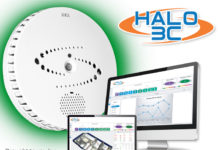By Kalyn Sims, Hexagon Safety & Infrastructure
Year over year, the pace of technology innovation is accelerating. Not too long ago, cloud and mobile technologies were the way of the future. Today, cloud and mobile have become mature and stable platforms that many industries and organizations have successfully adopted.
Every year, Gartner, IDC, Sullivan & Frost, and other technology consulting firms look into the near future and make predictions on what trends will effect organizations and industries over the next few years.
Some of the predicted trends align with the technology roadmaps of our public safety customers. And others don’t. So what about technology trends that support the needs for public safety and security agencies?
Between smart phones, mobile sensors, cameras, computers, cars, and more, advances in technology have exponentially increased the volume and types of data available to public safety agencies.
And it has become nearly impossible for agencies to manually make sense of the data within a timeframe for maximum impact. But the public safety technology needs go further than the exploiting big data and analytics to improve services.
Here’s a look at the technology trends that public safety and security organization will need to address and begin to adopt in 2017.
Information of Everything/Big Data Analytics
Devices are producing more information than ever before.
The challenge facing public safety agencies is how to make sense of all this information to improve business processes, but more importantly to solve crime and prevent it from happening.
Data from the device mesh needs to be sanitized, aggregated, and visualized in a manner that supports pattern recognition and anomaly identification, which will provide more informed data insight to the non-technical members of a public safety organization, including officers in the field and detectives.
Agencies need to be more proactive in their policing, rather than just reactive. To enable this, technology solutions must have embedded analytics that provide proactive alerts based on real-time data feeds.
The adoption of big data analytics solutions by public safety agencies is already occurring. Agencies have no choice but to address big data head on.
It is more a matter of how quickly solutions targeted toward public safety can be made available. Adoption of the cloud goes hand-in-hand with big data analytics because many of the big data solutions only operate in the cloud.
(Are you ready to see the whole picture when it comes to your public safety analytics? Analyst and Investigators need a single data platform to unite data sources and provide real insight into crime analysis. Courtesy of Hexagon Safety & Infrastructure and YouTube)
Technologies that Enable Citizen Involvement
Citizens are the eyes and ears of our communities. They know better than anybody when there is a suspicious person or vehicle in the neighborhood – when something “just doesn’t feel right”.
When an incident occurs, accounts from multiple witnesses can help to shape a case and lead to an arrest.
Technologies enabling anonymous entry by citizens enable agencies to acquire information that would otherwise go unreported due to fear of retaliation. Accounts of incidents received via 911, texts, and social media often help an agency determine the required response and appropriate resources.
Citizen portals, social media search, and social data aggregation tools are examples of how to take advantage of the information that lies in the hands of our citizens.
The adoption of citizen facing applications is already occurring.
Many public safety vendors that provide computer-aided dispatch and records management systems also provide the ability for citizens to report non-criminal incidents via portals or mobile applications.
The ability to harness data from citizen-based sources, such as social media sites, is being made available by a handful of vendors.
These technologies are slowly being adopted, but a struggle between agencies and regulatory organizations and privacy advocates could further complicate adoption and implementation of such technologies.
(Intergraph NetWorks is a flexible software suite that uses web services to provide secure, real-time access to location-based engineering and operational data and capabilities across the utility enterprise. Courtesy of Hexagon Safety & Infrastructure and YouTube)
Intelligent Automation
A combination of artificial intelligence and automation, intelligent automation enables organizations across vertical industries to achieve greater efficiencies and quality.
Intelligent automation systems actually learn and adapt as they drive through their workflows, enabling continuous process improvement. In the public safety and security industry, autonomous security robots is a perfect example of this trend.
Autonomous security robots will be a disruptive technology. The first wave of adoption will likely be in the industrial security market, where the costs of turnover and poor performance of human security guards are driving the need for robotics automation.
Look for the introduction of autonomous robot security guards in 2017. Adoption will start slow, as organizations watch for success stories, and then expect adoption to take off.
(Robots are taking over the world! No, not really. But they could take over some security patrol measures in the near future. Meet the Gamma 2 Robot in this episode of HxGN TV. Courtesy of Hexagon Safety & Infrastructure and YouTube)
Technologies that Address Cybercrime
Advances in technology bring many opportunities to those who are not so well intentioned, such as cyber criminals. Along with the Information of Everything trend, the instances of data theft, and even data manipulation, will increase.
Public Safety agencies will need to create new roles and organizations that specifically target cybercrime. This will require a combination of hiring new staff with cyber security expertise as well as training existing staff in this area.
As the Internet of Things continues to evolve, cyber criminals will attack a range of connected devices, widening the scope of their targets.
Agencies must have the expertise and technologies to not only protect their own assets, but to also investigate and deter cybercrime in the jurisdictions they serve.
It will take some time for agencies to ramp up their defenses against cybercrime, since the attackers are continuously evolving the sophistication of their methods with new targets and attacks.
It is less an issue of technology adoption for agencies, and more a challenge of building an organization with the correct skill sets and establishing processes to defend against cybercrime.
Ambient UX
Ambient UX is the user-centric design approach that enables information to appear at the right time, in the right place, in the right context, and on the right device.
The number of devices used by officers on a daily basis continues to grow, including desktops, laptops, notebooks, smartphones, body cameras, and radios.
The design of applications must take into consideration that an officer may use the application on multiple devices with multiple form factors. The user experience should adapt and be consistent as they move from device to device.
Breakthroughs in data analysis on user metrics and real-time operations enable UX teams to solve customer problems in new ways, from enhancing job-related skills and team collaboration to providing more situational awareness by giving people the right amount of meaningful data at the right time.
The user experience trend will be to incorporate emerging techniques and technologies into solutions, including powerful data analysis tools, gameful design, biometric data, and wearables to keep user safety and effectiveness at the heart of public safety solutions.
(Mobile is where it’s at for first responders. Join us as Safety & Infrastructure’s Gina Steadman shows us what’s new in mobile technology for public safety agencies around the globe in this HxGN TV episode. Courtesy of Hexagon Safety & Infrastructure and YouTube)
In addition to these current trends, there are the more mature trends of cloud and mobility.
While the public safety industry often lags a bit in innovation adoption, we are finally seeing a bigger push by agencies to embrace mobile technology. When compared with other industries cloud adoption is lagging too, but progress is being made.
One of the obstacles to cloud adoption is that legacy public safety systems are not cloud enabled. As vendors push to provide cloud-enabled solutions, we will see cloud adoption accelerate in the public safety industry.
About the Author, Kalyn Sims

Kalyn Sims is the chief technology officer of Hexagon Safety & Infrastructure. Her focus is on the growth and development of new product offerings and innovative technology.
Sims joined Hexagon Safety & Infrastructure in 2011 through an acquisition of her company, Denali Solutions, which she founded in 2000.
Prior to founding Denali Solutions, Sims worked as a management consultant and software engineer for several corporations, including Booz, Allen & Hamilton, and Thermo Electron.
She holds a bachelor’s degree in computer science and a master’s in business administration.
Original post http://www.hexagonsafetyinfrastructure.com/blog/2017/01/10/top-public-safety-and-security-tech-trends-for-2017






















